Architectural Education for Sustainability—Case Study of a Higher Education Institution from Poland
Abstract
1. Introduction
1.1. The Global Context of EU and UN Policies for Architectural Education
1.2. Formal Requirements for Sustainability in Architecture Studies in Poland
- Environmental protection and ecology;
- Conservation of the surrounding environment;
- Responsibility for environmental protection;
- Responsibility for shaping the environment and landscape;
- The importance of the natural environment;
- The role and importance of the natural environment in design;
- Ecologically responsible sustainable design;
- Environmental considerations;
- Principles of energy-efficient design;
- Energy-efficient building design.
- The ability to recognise the relationship between people and architecture, as well as architecture and the environment.
- The ability to evaluate the state of land use.
- The use of methods and tools to implement ecologically responsible sustainable design.
- Protection and conservation of the surrounding environment.
- Fostering responsibility for technical decisions, the protection of cultural and natural heritage, and the transmission of these values to future generations.
- Understanding the role of the natural environment in architectural design, urban planning, and spatial planning, along with the importance of spatial order and sustainable development.
2. State of Research
2.1. Review of EU and UN Policies in the Context of Sustainability in Higher Education for Sustainable Development
- (i)
- By integrating ESD topics into all relevant subjects, programmes and courses;
- (ii)
- By providing subject specific thematic programmes and courses; provide insight into the issue of global, regional, national and local environmental problems [18].
- Making green transition and sustainable development one of the priority areas of education and training policies and programmes;
- Providing opportunities for learners to understand issues related to the climate crisis and sustainable development in both formal and non-formal learning (e.g., in extra-curricular activities and youth work);
- Providing support to educators to deepen their knowledge and develop the skills needed to teach about the climate crisis and sustainability.
2.2. Overview of International Research on ESD Challenges
- “fringe reputation” (knowledge offered in elective classes).
- “number crunching” (emphasis on quantitative rather than qualitative matters).
- “The Beaux Arts tradition” (societal ethics or environmental awareness are not embedded in the agenda but only technical and aesthetic aspects), lack of support.
- “the old guard” (limited knowledge and lack of experience of tutors).
- “holistic vs. fragmented” (conventional linear approach where different technical skills are segregated in different departments).
- “what crisis?” (little systematic awareness of the relationship of building and urban design with vital environmental issues).
- “lack of support”.
2.3. An Overview of Research on Sustainable Architectural Education in Poland
- Reasons for conducting research;
- Methods of conducting research;
- Proposed corrective actions AES.
- Review of curricula (28 articles);
- Analysis of student work (18 articles);
- Conducting a survey among students (11 articles).
- Large-scale analysis of the whole year of student works (not a single course analysis).
- Consideration of the vocabulary used to describe the most synthetic summary of the students’ concepts.
- Recognising the gaps within the students’ understanding of different areas of sustainability based on SDGs, EGD, and NEB.
- An understanding of the different aspects of sustainability and their systematisation (20 articles).
- Interdisciplinary approaches (20 articles).
- Collaboration (e.g., working in groups, with external actors) (19 articles).
- Conducting research as an integral part of the design process (18 articles).
- Introducing support and verification tools (e.g., BIM, analytical tools) (13 articles).
- Thinking and acting locally (13 articles).
- Thinking and acting globally (13 articles).
- Creating a grading and evaluation system for created projects (for students and teachers) (11 articles).
2.4. Relative Occurrence of Terms Related to Sustainability in Architectural Student Competitions
3. Materials and Methods
3.1. Primary Research Materials
3.2. Identification of Priority Areas
- -
- Sustainability, from climate goals to circularity, zero pollution, and biodiversity.
- -
- Aesthetics, quality of experience and style beyond functionality.
- -
- Inclusion, from valuing diversity to securing accessibility and affordability.
3.3. Auxiliary Priority Area
3.4. Key Topics of Sustainable Priority Areas
3.5. Method of Examining Theses
- Frequency of Occurrence (FO) of SPAs.
- Relative Frequency of Occurrence (RFO) of SPAs in comparison with comparative baseline, as described in Section 3.6.
- Comparative analysis of Bachelor’s and Master’s degree.
3.6. The Comparative Baseline
- 30%—architecture of the new construction area;
- 30%—sustainable construction of the new construction area;
- 20%—architecture of the renovation area;
- 20%—sustainable construction of the renovation area.
4. Results
4.1. Frequency of Occurrence of Sustainable Priority Areas
4.1.1. Frequency of Occurrence of Sustainable Priority Areas in All Theses
4.1.2. Comparison of the Frequency of Occurrence of the Sustainable Priority Areas in Bachelor’s and Master’s Theses
4.2. The Relative Frequency of Occurrence of Different Susytainable Priority Areas in the Comparative Baseline
4.3. Relative Frequency of Occurrence of Different Priority Areas
4.3.1. Relative Frequency of Occurrence of Different Priority Areas in All Theses
4.3.2. Relative Frequency of Occurrence of Different Priority Areas in Bachelor’s and Master’s Diplomas
4.4. Summary of Analysis of Abstracts in Theses and Competitions
Validation of the Research Method
- Correlation coefficient for SDG priority areas: r(16) = 0.84, p < 0.01 (Figure 10a);
- Correlation coefficient for EGD priority areas: r(7) = 0.88, p < 0.01 (Figure 10b);
- Correlation coefficient for NEB priority areas: r(3) = 0.68, p = 0.21 (Figure 10c).
5. Discussion
5.1. Observed Trends in Student Work
5.1.1. Occurrence of Priority Areas
5.1.2. Generality of Prioritised Areas
5.1.3. Sustainability Issues in Theses
5.1.4. Specialisation of Studies
5.1.5. Technological Solutions vs. Sociological Issues
5.2. Potential Areas of Neglect
5.2.1. Curriculum
5.2.2. Thesis Requirements
5.2.3. Educational Standards for Architects
5.3. Potential Initiatives for Improvement
6. Conclusions
6.1. Main Results
6.2. Limitations of the Study
- The lack of access to the full content of the theses, including the full description and the graphic design.
- The limitation of the study to one year of graduation in one university.
- The nature of the evaluation conducted based on the SDGs, EGD, and NEB frameworks.
- The risks of misuse and overuse of terms in sustainable development.
6.3. Future Research
Author Contributions
Funding
Conflicts of Interest
Abbreviations
| AES | Architectural education for sustainability |
| HEI | Higher education institutions |
| UN | United Nations |
| EU | European Union |
| SDGs | Sustainable Development Goals |
| EGD | European Green Deal |
| NEB | New European Bauhaus |
| FA-WUST | Faculty of Architecture at Wrocław University of Science and Technology |
| WUST | Wrocław University of Science and Technology |
| HESI | Higher Education Sustainability Initiative |
| ESD | Education for Sustainable Development |
| MDPI | Multidisciplinary Digital Publishing Institute |
| WTE&TE | World Transactions on Engineering and Technology Education |
| PKA | Polish Accreditation Committee |
| SPA | Sustainable Priority Area |
| FO | Frequency of Occurrence |
| RFO | Relative Frequency of Occurrence |
| AUX | Auxiliary Priority Area |
Appendix A
| University Name | University Type According to OPI/PIB | Offered Level of Education | Name of the Faculty/Department/Unit |
|---|---|---|---|
| Cracow University of Technology | polytechnic | 1/2/3 | Faculty of Architecture |
| Gdańsk University of Technology | polytechnic | 1/2/3 | Faculty of Architecture |
| Wroclaw University of Science and Technology | polytechnic | 1/2/3 | Faculty of Architecture |
| Warsaw University of Technology | polytechnic | 1/2/3 | Faculty of Architecture |
| Silesian University of Technology | polytechnic | 1/2/3 | Faculty of Architecture |
| Lublin University of Technology | polytechnic | 1/2 | Faculty of Civil Engineering and Architecture |
| Poznan University of Technology | polytechnic | 1/2/3 | Faculty of Architecture |
| Lodz University of Technology | polytechnic | 1/2/3 | Faculty of Civil Engineering, Architecture and Environmental Engineering |
| Bialystok University of Technology | polytechnic | 1/2 | Faculty of Architecture |
| West Pomeranian University of Technology in Szczecin | university | 1/2/3 | Faculty of Architecture |
| Bydgoszcz University of Science and Technology | agricultural | 1/2 | Faculty of Civil Engineering, Architecture and Environmental Engineering |
| Opole University of Technology | polytechnic | 1/2/3 | Faculty of Civil Engineering and Architecture |
| Rzeszow University of Technology | polytechnic | 1/2/3 | Faculty of Civil and Environmental Engineering, and Architecture |
| Andrzej Frycz Modrzewski Krakow University | higher education | 1/2/3 | Faculty of Architecture and Fine Arts |
| University of Zielona Góra | university | 1/2 | Faculty of Structural Engineering, Architecture and Environmental Engineering |
| Kielce University of Technology | polytechnic | 1/2 | Faculty of Civil Engineering and Architecture |
| University of Ecology and Management | higher education | 1/2 | Faculty of Architecture |
| Academy of Silesia | vocational college | 1/2/3 | Faculty of Architecture, Construction and Applied Arts |
| Sopot University of Applied Sciences | vocational college | 1/2 | Faculty of Architecture, Engineering and Art |
| State University of Applied Sciences in Racibórz | vocational college | 1 | Faculty of Architecture |
| University of Applied Sciences in Nowy Targ | vocational college | 1/2 | Technical Institute |
| University of Applied Sciences in Nysa | vocational college | 1 | Faculty of Architecture |
| Academy of Film, Art and Design | higher education | 1 | Faculty of Architecture |
| University College of Enterprise and Administration in Lublin | vocational college | 1/2 | Faculty of Technical Sciences |
Appendix B
| Articles | Journal |
|---|---|
| [39,40,42,44,46,48,49,51,52,81,82,83,84,85,86,87,88,89] | World Transactions on Engineering and Technology Education |
| [34,41,45,47,90] | Sustainability, MDPI |
| [91] | Buildings, MDPI |
| [33,35,43,50,53,92] | Other |
| Articles | University |
|---|---|
| [33,40,42,44,45,47,50,53,84,85,86,89] | Cracow University of Technology |
| [34,35,39,41,52,81,91,92] | Wrocław University of Science and Technology |
| [49,51,82,83] | Kielce University of Technology |
| [44,87,88,90] | Academy of Fine Arts in Cracow |
| [46,48] | Gdańsk University of Technology |
| [43,45,46,47,52] | other |
Appendix C
| EGD | SDGs | NEB |
|---|---|---|
| - | No Poverty | - |
| Fair, Healthy and Environmentally-friendly Food System | Zero Hunger | - |
| - | Good Health and Well-being | - |
| - | Quality Education | - |
| - | Gender Equality | - |
| - | Clean Water and Sanitation | - |
| Clean, Affordable and Secure Energy Climate Neutrality and Adaptation to Climate Change Clean and Circular Economy Building and Renovating in an Energy and Resource Efficient Way Sustainable and Smart Mobility | Affordable and Clean Energy | Climate Goals |
| Clean and Circular Economy | Decent Work and Economic Growth | - |
| Clean and Circular Economy Building and Renovating in an Energy and Resource Efficient Way Sustainable and Smart Mobility Zero Pollution for a Toxic-free Environment | Industry, Innovation and Infrastructure | Circularity Zero Pollution |
| - | Reduced Inequalities | - |
| Building and Renovating in an Energy and Resource Efficient Way Clean and Circular Economy Sustainable and Smart Mobility Climate Neutrality and Adaptation to Climate Change | Sustainable Cities and Communities | Circularity |
| Clean and Circular Economy Building and Renovating in an Energy and Resource Efficient Way | Responsible Consumption and Production | Circularity |
| Climate Neutrality and Adaptation to Climate Change Zero Pollution for a Toxic-free Environment Clean and Circular Economy | Climate Action | Climate Goals Zero Pollution |
| Ecosystem and Biodiversity Restoration and Conservation | Life Below Water | Climate Goals Biodiversity |
| Ecosystem and Biodiversity Restoration and Conservation | Life on Land | Climate Goals Biodiversity |
| - | Peace, Justice and Strong Institutions | - |
| - | Partnership for the Goals | - |
Appendix D
| SPA Number | SDG | Key Topics |
|---|---|---|
| 1 | No Poverty | architecture building concepts combating poverty; affordable housing, temporary buildings (e.g., support homeless people/migrants on their journey to stability and ownership) |
| 2 | Zero Hunger | architecture building concept improving malnutrition conditions in underserved regions; permaculture, urban agriculture, farms, vertical farm, vertical gardens, community gardens |
| 3 | Good Health and Well-being | comfort, daylight, well-being, fresh air, clean air, mechanical ventilation (e.g., to provide fresh and filter air), natural ventilation, building overheating, healthy microclimate, mental health, healing architecture, ergonomic, areas for physical activity |
| 4 | Quality Education | schools, educational centres, and kindergartens, with particular attention to communities with limited access to formal education systems; environmental/climate/regional/sustainable education (e.g., educational centers focused on raising ecological and environmental awareness within communities, enhancing knowledge about sustainable design) |
| 5 | Gender Equality | tolerance, gender equality, buildings designed to support gender equality, such as women’s centres that provide opportunities for personal development and financial independence |
| 6 | Clean Water and Sanitation | rainwater, rainwater harvesting, grey water, water treatment plant, greywater, water filtration, water recirculation |
| 7 | Affordable and Clean Energy | renewable energy sources (RESs), energy savings, energy storage, energy efficiency, energy sufficiency, energy need for heating and cooling, energy performance, U-value, passive/active strategies, passive house, heating, cooling, convection, heat recovery, solar chimney (e.g., utilises renewable solar energy for passive heating and ventilation, significantly reducing reliance on traditional energy sources), solar gains, thermal buffer, wind turbines, low-energy, self-sufficient, autonomous |
| 8 | Decent Work and Economic Growth | rationality, investment, work–life balance, coworking |
| 9 | Industry Innovation and Infrastructure | innovative solutions (e.g., that improve energy efficiency, optimisation), high-tech, computer-aided design, modularity, prefabrication, algae, hempcrete (e.g., as example of innovative, more efficient and sustainable use of materials), machine learning, BIM, simulations, artificial intelligence (AI), 3D printing |
| 10 | Reduced Inequalities | accessibility, disability, inclusivity, universal design, accessible architecture, education (e.g., referring to regions with limited access), visually impaired, hearing impaired, single mothers, social exclusion, social anxiety, wheelchairs, refugees, migrants, homeless individuals, assistive architecture, rehabilitation, resocialization (e.g., reintegration in the country for war migrants, addressing the challenges of isolation) |
| 11 | Sustainable Cities and Communities | sustainability, sustainable development |
| social aspects: social activation, local activity centres, community, habitat, coliving, cohousing, coworking, local community integration, reduce isolation and increase social integration, surveys (e.g., engage communities in the design process) | ||
| context narrative: context (refers to the environmental, social, economic, cultural, and geographical factors of a project’s location, analysed to create effective, tailored solutions), environmental conditions, natural environment, heritage conservation, cultural preservation, environmental impact, ecological corridors, vernacular architecture, house on water (e.g., growing need for architecture that is adaptive to both changing climatic conditions and local environmental factors) | ||
| transportation issues: low-emission transport, low carbon footprint, car-free community, public transport, bicycles, carsharing, shared cars, electric vehicles, vehicle charging | ||
| 12 | Responsible Consumption and Production | embodied energy, carbon footprint, ecological footprint, circular economy, low-emission, zero-emission, zero-waste, waste (e.g., using waste materials for building), segregation resource recovery, reduction, recycling, reduce, reuse, recycle, closed-loop system, LCA, local materials, low-carbon footprint materials, cross-laminated timber (CLT) (e.g., reducing CO2 emissions; renewable material, possible recycling), wooden structure, rammed earth, earth building, low tech (e.g., use of natural, local materials, easy to repair) |
| 13 | Climate Action | climate changes, climatic gentrification, global warming, sustainability, sustainable development, resilience, regeneration, climate manifestation, climate neutral, decarbonisation, protection of ecosystems, environmental impact, nature-based solutions, smart bioclimatic design; greenery enhancing climate resilience, e.g., cool roofs, urban greenery, green roofs, green walls, eco-walls, green bus stop, rain gardens, tree planting), house on water (e.g., result from climate change and the rising sea levels worldwide); actions focusing of affordable and clean energy; utilising local culture, topographic and climatic conditions |
| 14 | Life Below Water | blue–green infrastructure, natural compensation (e.g., using natural systems like wetlands to mitigate negative impacts), ecosystems (e.g., water reservoir, wetlands), biodiversity (water ecosystems), natural/environmental analysis (e.g., of water flow, water ecosystems, migration); retention, rainwater, water treatment plant, greywater, biophilic design (e.g., design spaces with water elements), hydroponics, rain gardens |
| 15 | Life and Land | blue–green infrastructure, natural compensation, natural/environmental analysis, resources, restoration of biologically active surfaces, biodiversity, ecosystems, fourth nature, allocentric design, biophilia, bionics, biomimicry, rain gardens, green walls, green roofs, pollinators in cities, cool roofs, urban greenery, green roofs, green walls, eco-walls, green bus stop, rain gardens, tree planting |
| 16 | Peace, Justice and Strong Institutions | not found |
| 17 | Partnership for the Goals | not found |
| Additional | ||
| 18 | Auxiliary Priority Area * | regeneration, adaptation, repair, modernisation, renovation, revitalisation |
References
- Richardson, J.; Steffen, W.; Lucht, W.; Bendtsen, J.; Cornell, S.E.; Donges, J.F.; Drüke, M.; Fetzer, I.; Bala, G.; Von Bloh, W.; et al. Earth Beyond Six of Nine Planetary Boundaries. Sci. Adv. 2023, 9, 37. [Google Scholar] [CrossRef] [PubMed]
- IPCC. Summary for Policymakers. In Climate Change 2021: The Physical Science Basis. Contribution of Working Group I to the Sixth Assessment Report of the Intergovernmental Panel on Climate Change; Masson-Delmotte, V., Zhai, P., Pirani, A., Connors, S.L., Péan, C., Berger, S., Caud, N., Chen, Y., Goldfarb, L., Gomis, M.I., et al., Eds.; Cambridge University Press: Cambridge, UK, 2021; In Press. [Google Scholar]
- United Nations Environment Programme. Global Status Report for Buildings and Construction: Beyond Foundations: Mainstreaming Sustainable Solutions to Cut Emissions from the Buildings Sector; UNEP: Nairobi, Kenya, 2024. [Google Scholar] [CrossRef]
- Directive (EU) 2024/1275 of the European Parliament and of the Council of 24 April 2024 on the Energy Performance of Buildings, EU, Brussels. Available online: https://eur-lex.europa.eu/legal-content/EN/TXT/?uri=OJ:L_202401275 (accessed on 24 August 2024).
- Ripple, W.J.; Wolf, C.; Newsome, T.; Barnard, P.; Moomaw, W.; de Moura, C. World Scientists’ Warning of a Climate Emergency. BioScience 2020, 70, 8–12. [Google Scholar] [CrossRef]
- Regulation (EU) 2021/1119 of the European Parliament and of the Council of 30 June 2021 Establishing the Framework for Achieving Climate Neutrality and Amending Regulations (EC) No 401/2009 and (EU) 2018/1999 (‘European Climate Law’). Available online: https://eur-lex.europa.eu/eli/reg/2021/1119/oj/eng (accessed on 6 April 2025).
- European Commission. Delivering the European Green Deal. Available online: https://ec.europa.eu/info/strategy/priorities-2019-2024/european-green-deal/delivering-european-green-deal_en (accessed on 24 August 2021).
- Directive (EU) 2023/1791 of the European Parliament and of the Council of 13 September 2023 on Energy Efficiency and Amending Regulation (EU) 2023/955 (Recast). Available online: https://eur-lex.europa.eu/legal-content/EN/TXT/?uri=OJ%3AJOL_2023_231_R_0001&qid=1695186598766 (accessed on 20 September 2024).
- European Commission. European Green Deal: Commission Proposes Transformation of EU Economy and Society to Meet Climate Ambitions. Available online: https://ec.europa.eu/commission/presscorner/detail/en/IP_21_3541 (accessed on 24 August 2021).
- Bashmakov, I.A.; Nilsson, L.J.; Acquaye, A.; Bataille, C.; Cullen, J.M.; de la Rue du Can, S.; Fischedick, M.; Geng, Y.; Tanaka, K. Industry. In IPCC, Climate Change 2022: Mitigation of Climate Change. Contribution of Working Group III to the Sixth Assessment Report of the Intergovernmental Panel on Climate Change; Shukla, P.R., Skea, J., Slade, R., Al Khourdajie, A., van Diemen, R., McCollum, D., Pathak, M., Some, S., Vyas, P., Fradera, R., et al., Eds.; Cambridge University Press: Cambridge, UK; New York, NY, USA, 2022; p. 1213. [Google Scholar] [CrossRef]
- Ustawa Prawo Budowlane, Tekst Jednolity: Dz.U. 2023 poz. 682, z Późniejszymi Zmianami. Available online: https://isap.sejm.gov.pl/isap.nsf/DocDetails.xsp?id=WDU20230000682 (accessed on 15 May 2024).
- OPI/PIB Science Poland. Available online: https://nauka-polska.pl/#/home/search?_k=oap4pt. (accessed on 15 May 2024).
- Ustawa z Dnia 20 Lipca 2018 r.—Prawo o Szkolnictwie Wyższym i Nauce z Późniejszymi Zmianami. Available online: https://isap.sejm.gov.pl/isap.nsf/DocDetails.xsp?id=WDU20180001668. (accessed on 15 May 2024).
- Rozporządzenie Ministra Nauki i Szkolnictwa Wyższego z dnia 18 Lipca 2019 r. w Sprawie Standardu Kształcenia Przygotowującego do Wykonywania Zawodu Architekta. Available online: https://isap.sejm.gov.pl/isap.nsf/DocDetails.xsp?id=WDU20190001359 (accessed on 15 May 2024).
- Polska Polityka Architektoniczna. Polityka Jakości Krajobrazu, Przestrzeni Publicznej, Architektury; Izba Architektów RP Polish Architectural Policy 2011; Polska Rada Architektury; SARP; TUP: Warszawa, Poland, 2011. [Google Scholar]
- 18UN General Assembly. Transforming Our World: The 2030 Agenda for Sustainable Development, A/RES/70/1, 21 October 2015. Available online: https://www.refworld.org/legal/resolution/unga/2015/en/111816 (accessed on 15 May 2024).
- Higher Education Sustainability Initiative. Available online: https://sdgs.un.org/HESI (accessed on 15 May 2024).
- UN Economic Commission for Europe; Committee on Environmental Policy. UNECE Strategy for Education for Sustainable Development. In Proceedings of the High-Level Meeting of Environment and Education Ministries, Vilnius, Lithuania, 17–18 March 2005. [Google Scholar]
- European Commission. Communication (COM/2020/625 Final) from the Commission to the European Parliament, the Council, the European Economic and Social Committee, and the Committee of the Regions on Achieving the European Education Area by 2025, 30 September 2020; European Commission: Luxembourg, 2020. [Google Scholar]
- Council Resolution on a Strategic Framework for European Cooperation in Education and Training Towards the European Education Area and Beyond (2021–2030) (2021/C 66/01). Available online: https://cpi.si/en/international-cooperation/current-eu-strategy-documents/council-resolution-on-a-strategic-framework-for-european-cooperation-in-education-and-training-towards-the-european-education-area-and-beyond-2021-2030/ (accessed on 6 April 2025).
- European Commission. Communication (COM/2020/628 Final) from the Commission to the European Parliament, the Council, the European Economic and Social Committee, and the Committee of the Regions: A New ERA for Research and Innovation; European Commission: Luxembourg, 2020. [Google Scholar]
- European Commission. Communication (COM(2020) 274 Final) from the Commission to the European Parliament, The Council, the European Economic and Social Committee, and the Committee of the Regions: European Skills Agenda for Sustainable Competitiveness, Social Fairness, and Resilience. Available online: https://eur-lex.europa.eu/legal-content/EN/TXT/?uri=CELEX%3A52020DC0274 (accessed on 15 May 2024).
- Council Recommendation of 16 June 2022 on Learning for the Green Transition and Sustainable Development (2022/C 243/01). Available online: https://eur-lex.europa.eu/legal-content/EN/TXT/?uri=oj:JOC_2022_243_R_0001 (accessed on 6 April 2025).
- Declaration of Interdependence for a Sustainable Future, AIA/UIA, 1993. Available online: https://www.uia-architectes.org/en/resource/chicago-declaration-1993-independence-for-a-sustainable-future/ (accessed on 6 April 2025).
- Cox, L. Copenhagen Declaration as of December 7, 2009. Proj. Baikal 2011, 8, 42–43. [Google Scholar] [CrossRef]
- Evans, N.; Ferreira, J.-A. What Does the Research Evidence Base Tell Us about the Use and Impact of Sustainability Pedagogies in Initial Teacher Education? Environ. Educ. Res. 2020, 26, 27–42. [Google Scholar] [CrossRef]
- Probst, L. Higher Education for Sustainability: A Critical Review of the Empirical Evidence 2013–2020. Sustainability 2022, 14, 3402. [Google Scholar] [CrossRef]
- Porras Álvarez, S.; Lee, K.; Park, J.; Rieh, S.-Y. A Comparative Study on Sustainability in Architectural Education in Asia—With a Focus on Professional Degree Curricula. Sustainability 2016, 8, 290. [Google Scholar] [CrossRef]
- Altomonte, S.; Rutherford, P.; Wilson, R. Mapping the Way Forward: Education for Sustainability in Architecture and Urban Design. Corp. Soc. Responsib. Environ. Manag. 2014, 21, 143–154. [Google Scholar] [CrossRef]
- Alkaher, I.; Avissar, I. Assessing the Impact of a Program Designed to Develop Sustainability Leadership Amongst Staff Members in Higher Education Institutes: A Case Study from a Community of Practice Perspective. Environ. Educ. Res. 2018, 24, 492–520. [Google Scholar] [CrossRef]
- Stasinopoulos, T.N. Sustainable Architecture Teaching in Non-Sustainable Societies. In Proceedings of the 22nd Conference on Passive and Low Energy Architecture, Beirut, Lebanon, 13–16 November 2005. [Google Scholar]
- Bonenberg, W.; Kapliński, O. The Architect and the Paradigms of Sustainable Development: A Review of Dilemmas. Sustainability 2018, 10, 100. [Google Scholar] [CrossRef]
- Celadyn, W. Postgraduate studies and sustainable architecture. Glob. J. Eng. Educ. 2018, 20, 54–58. [Google Scholar]
- Sadowski, K. Implementation of the New European Bauhaus Principles as a Context for Teaching Sustainable Architecture. Sustainability 2021, 13, 10715. [Google Scholar] [CrossRef]
- Bać, A.; Cebrat, K. Evolving the Education Process of Designing Sustainable Built Environment: A Case Study. In Proceedings of the 2nd International Multidisciplinary Scientific Conference on Social Sciences and Arts, SGEM 2015: Conference Proceedings, Albena, Bulgaria, 26 August–1 September 2015; pp. 377–384. [Google Scholar]
- Altomonte, S.; Yannas, S.; Herde, A.; Riemer, A.; Cangelli, E.; Horvath, S.; LopezDeAsiain, M. Education for Sustainable Environmental Design; The Educate Project; Educate Press: Nottingham, UK, 2012; ISBN 978-0-9573450-2-7. [Google Scholar]
- Altomonte, S.; Cadima, P.; Yannas, S.; Herde, A.; Riemer, H.; Cangelli, E.; LopezDeAsiain, M.; Horvath, S. Educate! Sustainable Environmental Design in Architectural Education and Practice. In Proceedings of the PLEA2012—28th Conference: Opportunities, Limits & Needs Towards an Environmentally Responsible Architecture, Lima, Peru, 7–9 November 2012. [Google Scholar]
- Cieciora, M.; Dębski, M.; Kacperska, E.; Kraciuk, J.; Łukasiewicz, K.; Pietrzak, P. Publication Activity of Public Higher Education Institutions in Poland Corresponding to the Idea of Sustainable Energy Development—Results of a Cluster Analysis. J. Intercult. Manag. 2023, 15, 200–224. [Google Scholar] [CrossRef]
- Drapella-Hermansdorfer, A. The path to sustainability: Architectural education for the future. World Trans. Eng. Technol. Educ. 2018, 16, 237–238. [Google Scholar]
- Haupt, P. Design with nature and design for the people—The principles of architectural education. World Trans. Eng. Technol. Educ. 2018, 16, 70–74. [Google Scholar]
- Brzezicki, M.; Jasiolek, A. A Survey-Based Study of Students’ Expectations vs. Experience of Sustainability Issues in Architectural Education at Wroclaw University of Science and Technology, Poland. Sustainability 2021, 13, 10960. [Google Scholar] [CrossRef]
- Jagiello-Kowalczyk, M. Integration of sustainable design issues from the first stage of the education process of architecture students. World Trans. Eng. Technol. Educ. 2017, 15, 23–27. [Google Scholar]
- Abyzov, V.; Bulakh, I.; Ustinova, I.; Safronova, O.; Safronov, v.; Semyroz, N. Sustainable Design in Architecture (The Case Study of the Educational Process at Universities in Poland and Ukraine). Civ. Eng. Archit. 2023, 11, 1255–1266. [Google Scholar] [CrossRef]
- Celadyn, M.; Celadyn, W. Toward the consistency of architecture and interior architecture curricula to accomplish sustainability goals. World Trans. Eng. Technol. Educ. 2023, 21, 153–158. [Google Scholar]
- Avsec, S.; Jagiełło-Kowalczyk, M. Investigating Possibilities of Developing Self-Directed Learning in Architecture Students Using Design Thinking. Sustainability 2021, 13, 4369. [Google Scholar] [CrossRef]
- Burda, I.; Zielonko-Jung, K.; Moutard, L.; Vapard, A.; Durand, A. Towards ecological transformation: Developing architectural education and research through L’Art Urbain initiatives. World Trans. Eng. Technol. Educ. 2024, 22, 64–69. [Google Scholar]
- Avsec, S.; Jagiełło-Kowalczyk, M.; Żabicka, A. Enhancing Transformative Learning and Innovation Skills Using Remote Learning for Sustainable Architecture Design. Sustainability 2022, 14, 3928. [Google Scholar] [CrossRef]
- Taraszkiewicz, A.; Taraszkiewicz, K. Ideas of the New European Bauhaus (NEB) in architectural education. World Trans. Eng. Technol. Educ. 2024, 22, 12–17. [Google Scholar]
- Gil-Mastelarczyk, J. Architectural education in the formation of the built environment with sustainable features. World Trans. Eng. Technol. Educ. 2020, 18, 146–151. [Google Scholar]
- Butelski, K. Sustainable Architectural Education, Between Theory and Practice—The Case of Lesser Poland. Preprints 2021. [Google Scholar] [CrossRef]
- Gil-Mastelarczyk, J. Impact of engineering education on sustainable local architectural practice. World Trans. Eng. Technol. Educ. 2020, 18, 473–478. [Google Scholar]
- Ceylan, S.; Jablonska, J. Sustainable architecture in education. World Trans. Eng. Technol. Educ. 2021, 19, 96–101. [Google Scholar]
- Schneider-Skalska, G. Sustainable design in education—continuity and integration. In Proceedings of the CESB16—Central Europe Towards Sustainable Building 2016: Innovations for Sustainable Future, Prague, Czech Republic, 22–24 June 2016; pp. 1594–1601. [Google Scholar]
- Celadyn, M. Green Building Awards as a tool for building knowledge of the sustainable design of interiors. World Trans. Eng. Technol. Educ. 2019, 17, 254–259. [Google Scholar]
- Competitions.archi. Available online: https://competitions.archi/ (accessed on 20 September 2024).
- Grzegorzewska, M.; Kaczmarek, A.; Kirschke, P. Environmental Assessments in Architectural Competitions in Poland in the Years 2018–2022. Buildings 2023, 13, 2839. [Google Scholar] [CrossRef]
- Archive of Diploma Theses. Available online: https://apd.usos.pwr.edu.pl/catalogue/ (accessed on 18 May 2024).
- United Nations, Department of Economic and Social Affairs, Sustainable Development, Transforming our World: The 2030 Agenda for Sustainable Development. Available online: https://docs.un.org/en/A/RES/70/1 (accessed on 18 May 2024).
- European Commission. The European Green Deal. Striving to Be First Climate-Neutral Continent. Available online: https://commission.europa.eu/strategy-and-policy/priorities-2019-2024/european-green-deal_en (accessed on 18 May 2024).
- European Union, New European Bauhaus. Available online: https://new-european-bauhaus.europa.eu/about/about-initiative_en (accessed on 18 May 2024).
- Netti, G. SOCI SDG Handbook; Lum Jean Monnet University: Casamassima, Italy, 2025; pp. 8–65. Available online: http://socisdg.com/media/1323/socisdg_finalpublishing.pdf (accessed on 6 April 2025).
- Mossin, N.; Stilling, S.; Bøjstrup, T.C.; Larsen, V.G.; Lotz, M.; Blegvad, A. (Eds.) The 17 Goals. In An Architecture Guide to the UN 17 Sustainable Development Goals, 2nd ed.; KADK: Copenhagen, Denmark, 2021; pp. 13–154. [Google Scholar]
- Retrofitting Existing Buildings to Improve Sustainability and Energy Performance. Available online: https://www.wbdg.org/resources/retrofitting-existing-buildings-improve-sustainability-and-energy-performance (accessed on 18 May 2024).
- Implementing Sustainability Measures in Existing Buildings. Available online: https://www.alpinme.com/sustainability-existing-buildings/ (accessed on 18 May 2024).
- Luca, E.; Sulc, I.; Haselsteiner, E. Regenerative Heritage. In Sustainability, Restorative to Regenerative; Brown, M., Haselsteiner, E., Apró, D., Kopeva, D., Luca, E., Pulkkinen, K.-L., Vula Rizvanolli, B., Eds.; COST Action CA16114 RESTORE, RESTORE Working Group One: Restorative Sustainability: Vienna, Austria, 2018; pp. 69–76. [Google Scholar]
- Vos, G.A.; Oostra, M.A.; Van Oppen, C. Circular Buildings: Strategies and Case Studies, 2nd ed.; Netherlands Enterprise Agency (Rijksdienst voor Ondernemend Nederland, RVO): Hague, The Netherlands, 2020; pp. 18–27. [Google Scholar]
- Creswell, J.W.; Creswell, J.D. The Selection of a Research Approach. In Research Design: Qualitative, Quantitative, and Mixed Methods Approaches, 5th ed.; SAGE Publications, Inc.: Los Angeles, CA, USA, 2018; pp. 51–52, 60. [Google Scholar]
- Relative Frequency. Available online: https://unacademy.com/content/jee/study-material/mathematics/relative-frequency/ (accessed on 30 December 2024).
- Saint-Gobain, Edition Helsinki 2024, Contest Task Presentation. Available online: https://architecture-student-contest.saint-gobain.com/last-editions/edition-helsinki-2024 (accessed on 20 September 2024).
- Newcastle University. Strength of Correlation. Available online: https://www.ncl.ac.uk/webtemplate/ask-assets/external/maths-resources/statistics/regression-and-correlation/strength-of-correlation.html (accessed on 6 April 2025).
- Freedman, D.; Pisani, R.; Purves, R. Statistics (International Student Edition), 4th ed.; WW Norton & Company: New York, NY, USA, 2007. [Google Scholar]
- Social Science Statistics. Pearson’s Correlation Coefficient Calculator. Available online: https://www.socscistatistics.com/tests/pearson/default2.aspx (accessed on 28 January 2025).
- Architektura i Urbanistyka. Available online: https://wa.pwr.edu.pl/kandydaci2/studia-ii-stopnia-2/architektura-i-urbanistyka (accessed on 6 April 2025).
- Architektura i Ochrona Zabytków. Available online: https://wa.pwr.edu.pl/kandydaci2/studia-ii-stopnia-2/architektura-i-ochrona-zabytkow (accessed on 6 April 2025).
- Specjalność Architektura i Urbanistyka. Available online: https://wa.pwr.edu.pl/studenci/studia-i-stopnia-2%20/programy-studiow-2/architektura-ii-stopnia/specjalnosc-architektura-i-urbanistyka (accessed on 18 May 2024).
- Specjalność Architektura i Ochrona Zabytków. Available online: https://wa.pwr.edu.pl/studenci/studia-i-stopnia-2%20/programy-studiow-2/architektura-ii-stopnia/specjalnosc-architektura-i-ochrona-zabytkow (accessed on 18 May 2024).
- Zasady Dyplomowania na Studiach Inżynierskich. Zasady Dyplomowania na Studiach Magisterskich. Available online: https://wa.pwr.edu.pl/studenci/studia-i-stopnia-2/dyplomanci-ii (accessed on 18 May 2024).
- Architecture Student Contest Saint Gobain. Edition 2024 Helsinki. Available online: https://architecture-student-contest.saint-gobain.com/edition-2024-helsinki (accessed on 18 May 2024).
- Architecture Student Contest Saint Gobain. Tools and Trainings. Available online: https://architecture-student-contest.saint-gobain.com/saint-gobain-solutions (accessed on 18 May 2024).
- Kaira Looro Competition. Available online: https://www.kairalooro.com/competition_2025_nursery_school/en_about.html (accessed on 30 December 2024).
- Widera, B.; Woźniczka, A. Developing sustainable resilience through forecasting and backcasting in architectural education. World Trans. Eng. Technol. Educ. 2022, 20, 39–44. [Google Scholar]
- Gil-Mastelarczyk, J.; Kowalczyk, M. Sustainability in selected design strategies in architectural education. World Trans. Eng. Technol. Educ. 2023, 21, 241–247. [Google Scholar]
- Gil-Mastelarczyk, J. Developing engineering competence and engagement in the sustainable development idea through a flexible and creative approach. World Trans. Eng. Technol. Educ. 2022, 20, 124–130. [Google Scholar]
- Schneider-Skalska, G. Sustainability and environmental protection in housing design education. World Trans. Eng. Technol. Educ. 2018, 16, 101–107. [Google Scholar]
- Celadyn, W. Energy as an issue in architectural diploma designs. World Trans. Eng. Technol. Educ. 2018, 16, 12–17. [Google Scholar]
- Schneider-Skalska, G. Interdisciplinary education of architects both globally and locally. World Trans. Eng. Technol. Educ. 2018, 16, 356–361. [Google Scholar]
- Celadyn, M. Environmental sustainability considerations in an interior design curriculum. World Trans. Eng. Technol. Educ. 2017, 15, 317–322. [Google Scholar]
- Celadyn, M. Inner space elements in environmentally responsible interior design education. World Trans. Eng. Technol. Educ. 2016, 14, 495–499. [Google Scholar]
- Kobylarczyk, J. Examples of students’ sustainable design through association activities in the Faculty of Architecture at Cracow University of Technology. World Trans. Eng. Technol. Educ. 2017, 15, 374–378. [Google Scholar]
- Celadyn, M. Integrative Design Classes for Environmental Sustainability of Interior Architectural Design. Sustainability 2020, 12, 7383. [Google Scholar] [CrossRef]
- Cisek, E.; Jaglarz, A. Architectural Education in the Current of Deep Ecology and Sustainability. Buildings 2021, 11, 358. [Google Scholar] [CrossRef]
- Bać, A.; Kazanecka-Olejnik, L. Architectural Education—The Case Study. The Living Laboratory of Sustainability. In Proceedings of the 37th PLEA Conference, Sustainable Architecture and Urban Design, Wrocław, Poland, 26–28 June 2024; pp. 1579–1584. [Google Scholar] [CrossRef]
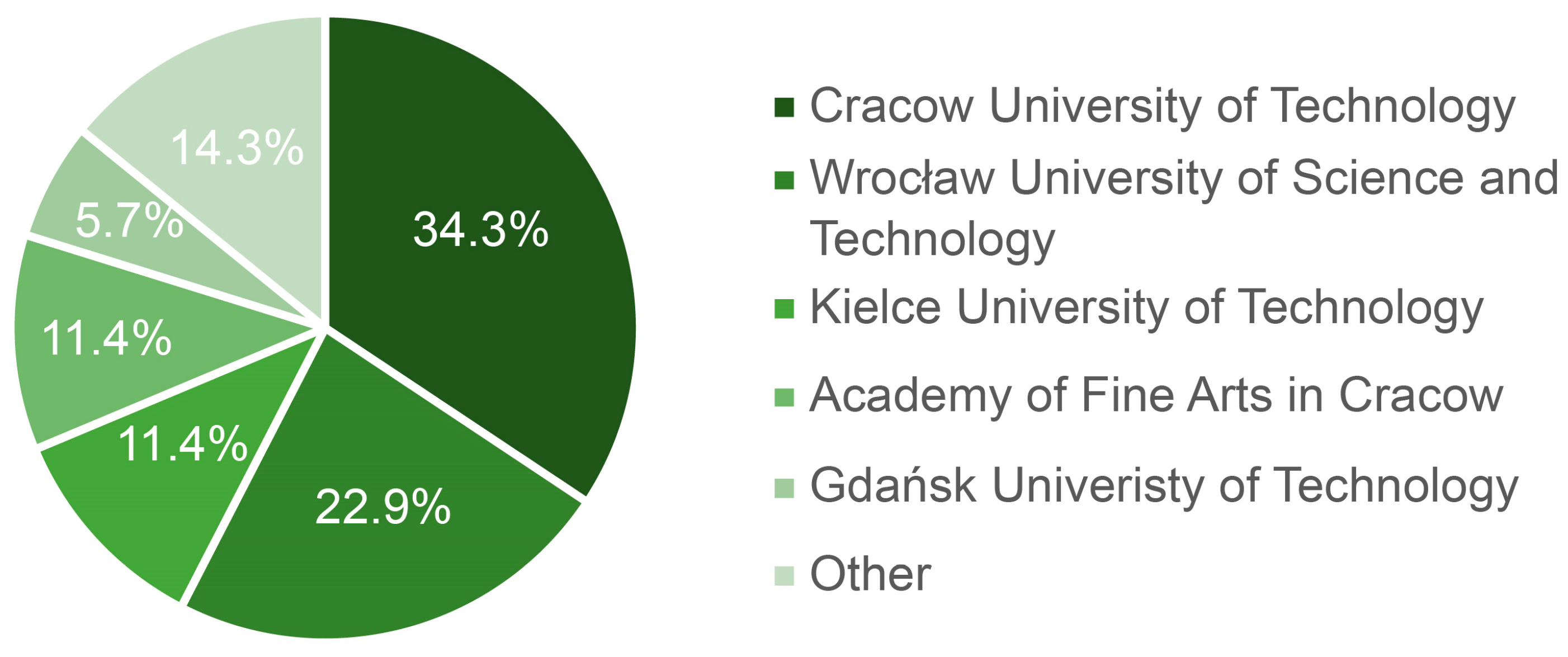

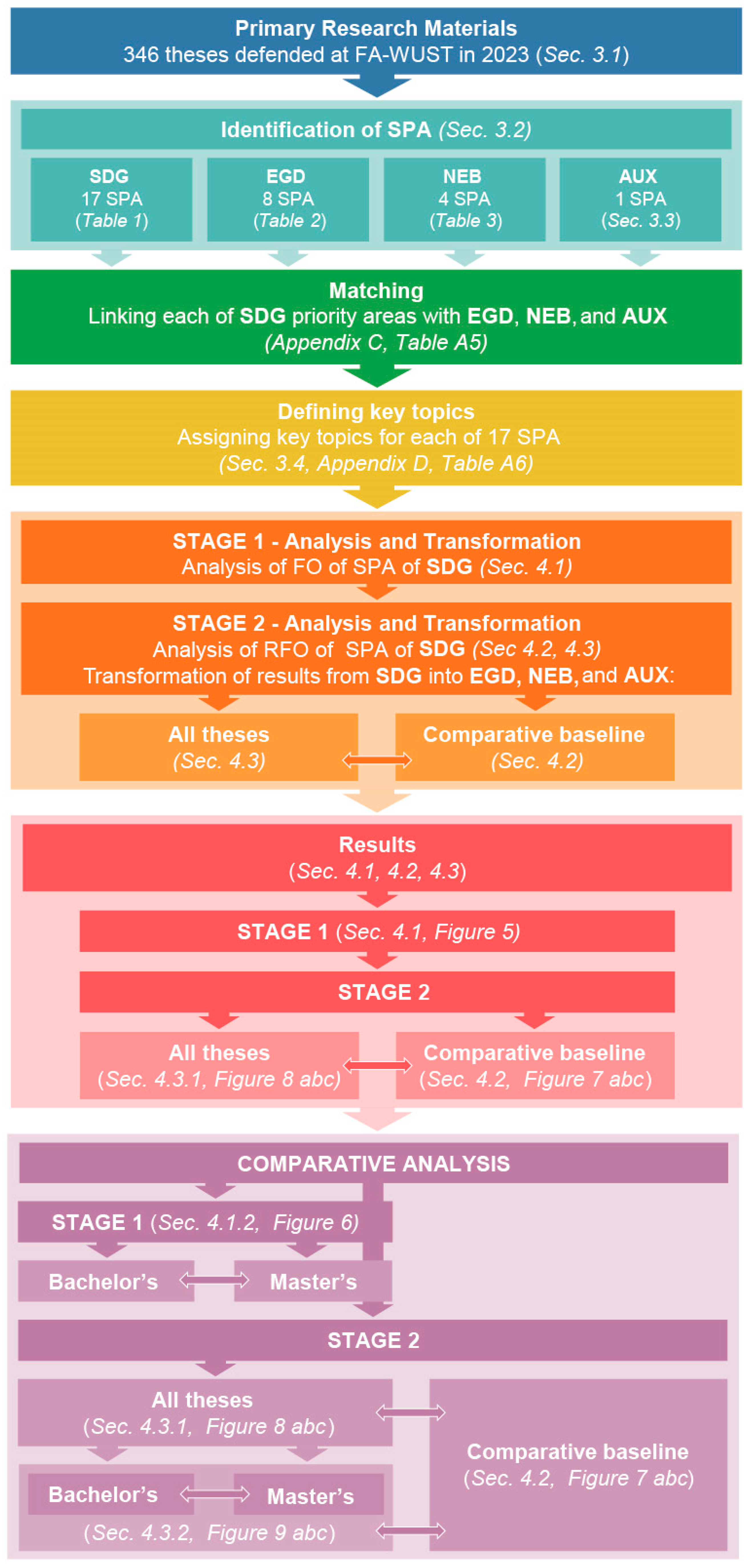
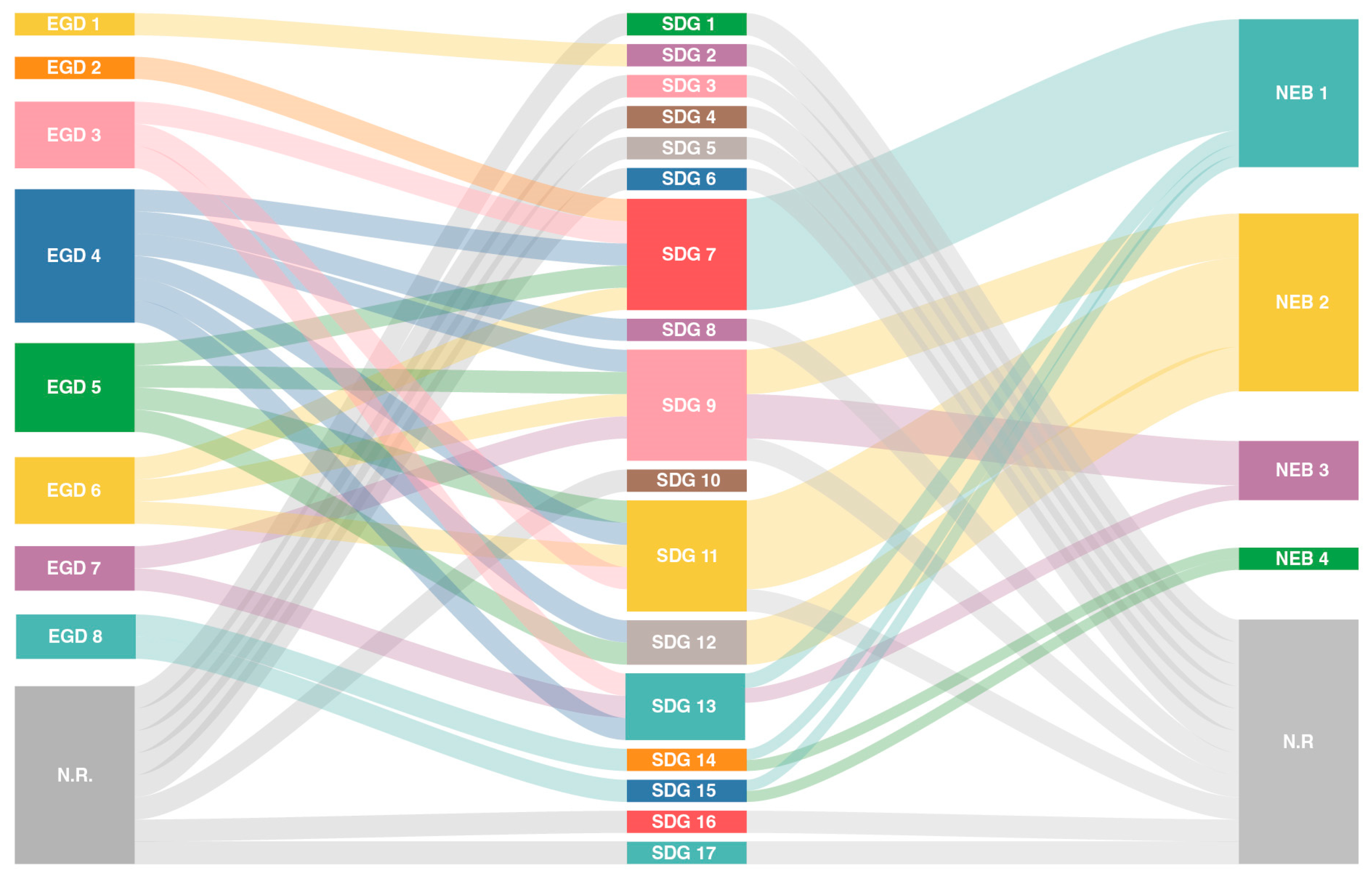

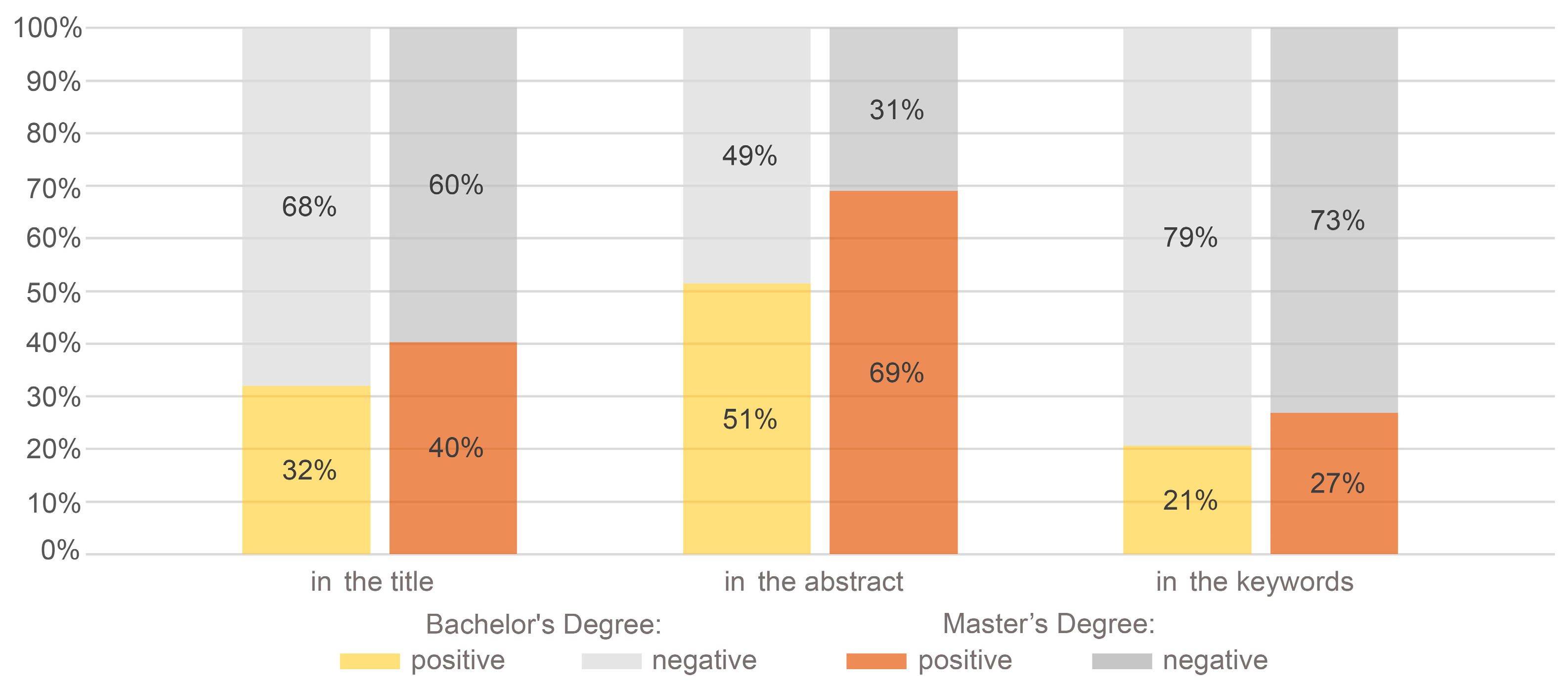
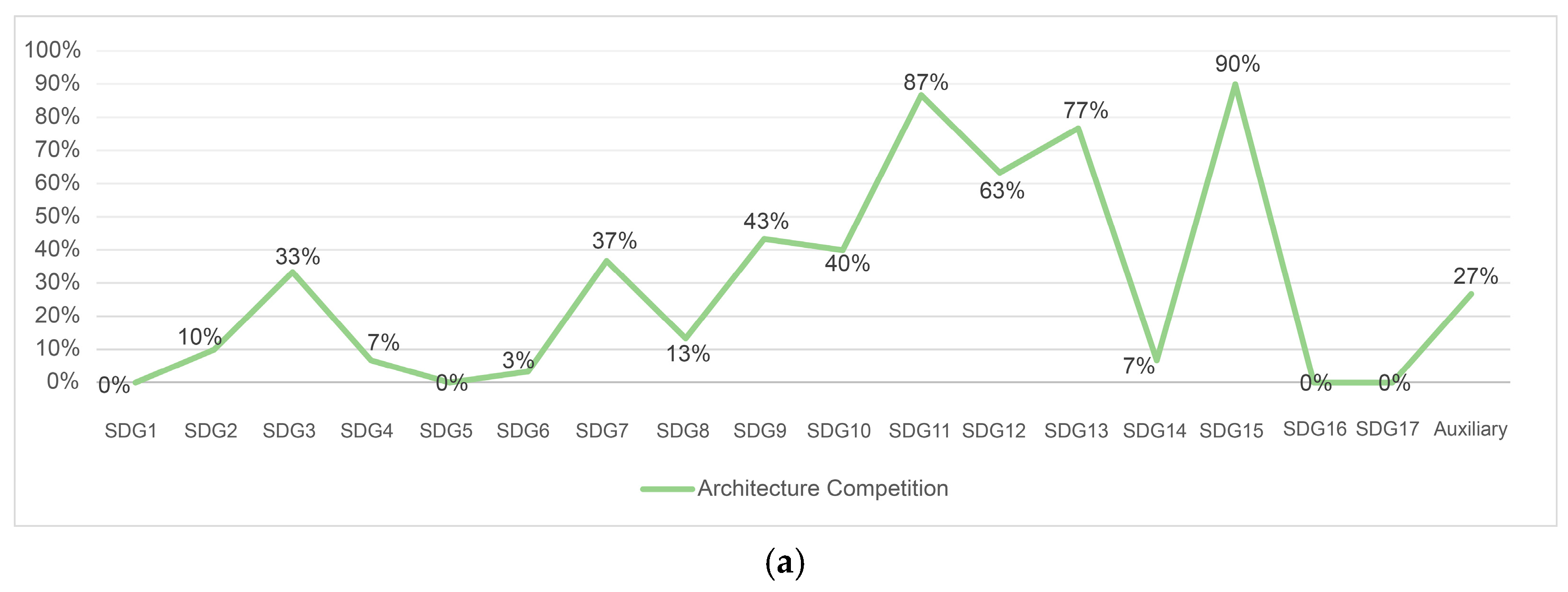

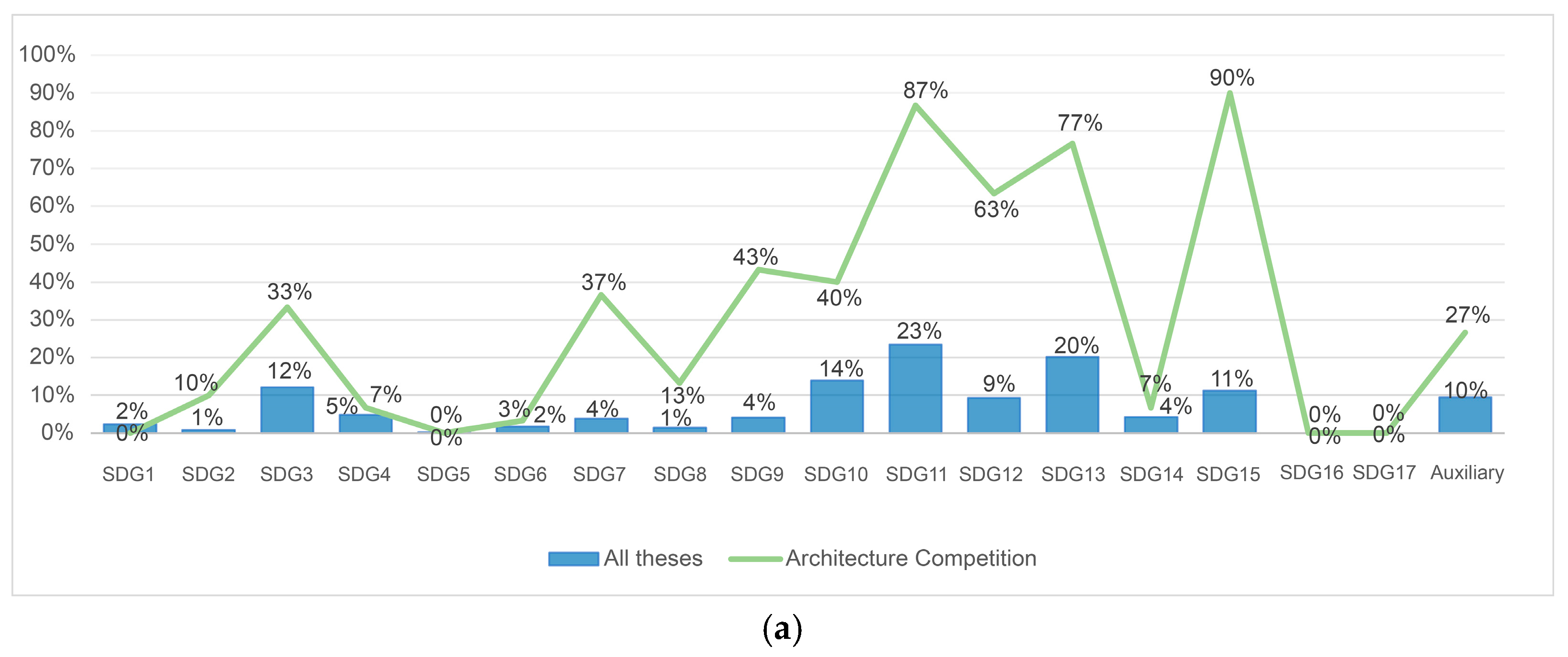
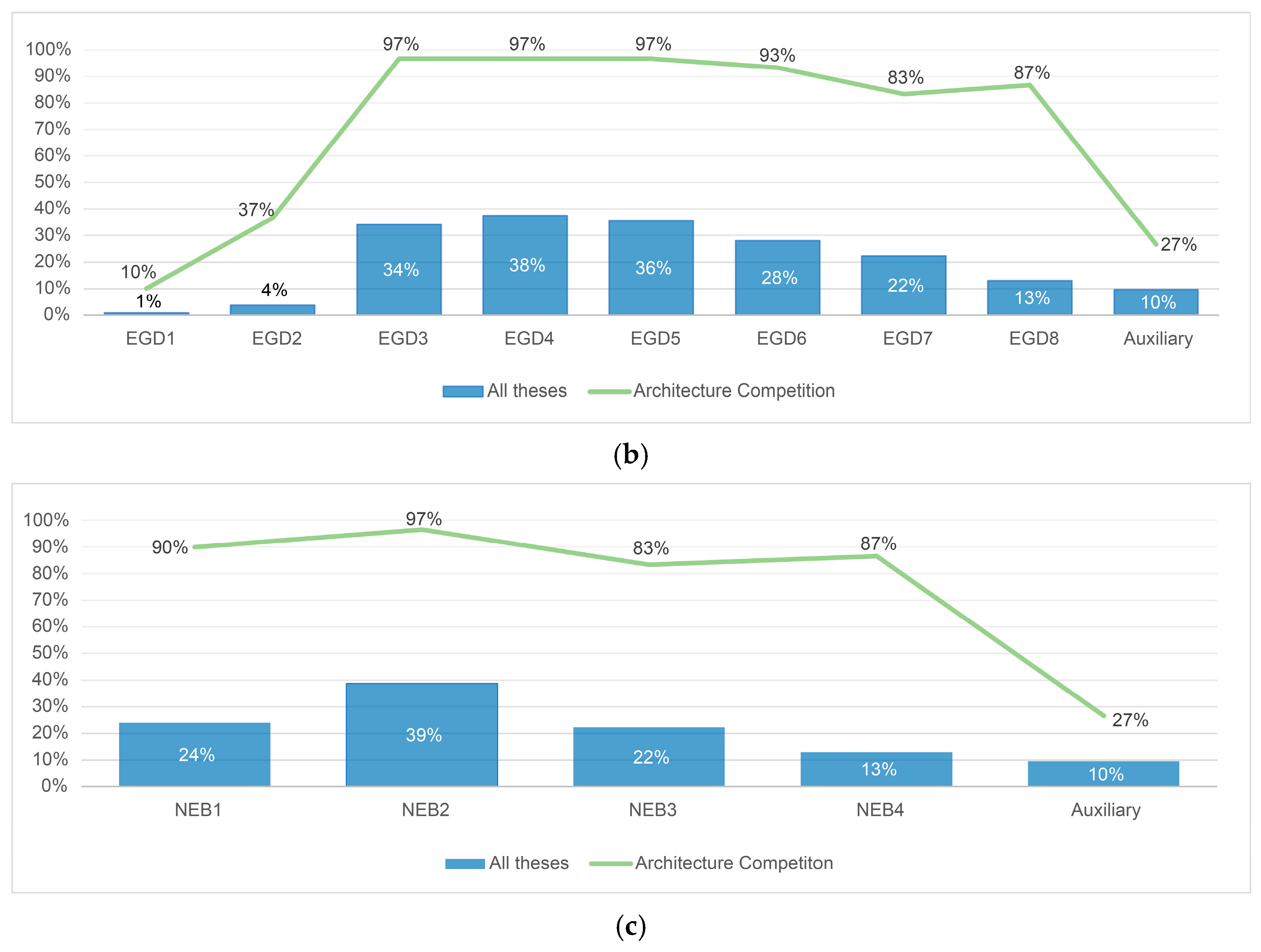
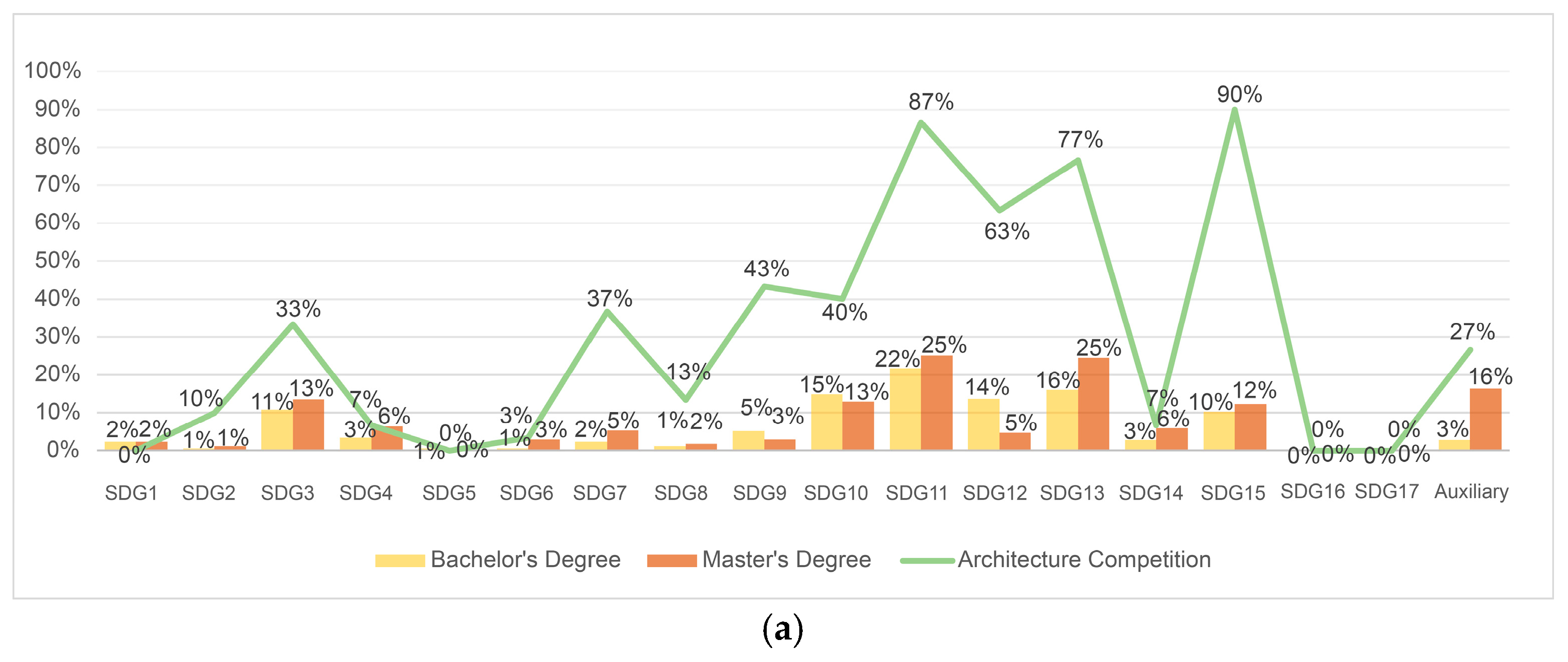


| Designation | Complete Designation |
|---|---|
| SDG 1 | No Poverty |
| SDG 2 | Zero Hunger |
| SDG 3 | Good Health and Well-being |
| SDG 4 | Quality Education |
| SDG 5 | Gender Equality |
| SDG 6 | Clean Water and Sanitation |
| SDG 7 | Affordable and Clean Energy |
| SDG 8 | Decent Work and Economic Growth |
| SDG 9 | Industry, Innovation and Infrastructure |
| SDG 10 | Reduced Inequalities |
| SDG 11 | Sustainable Cities and Communities |
| SDG 12 | Responsible Consumption and Production |
| SDG 13 | Climate Action |
| SDG 14 | Life Below Water |
| SDG 15 | Life and Land |
| SDG 16 | Peace, Justice and Strong Institutions |
| SDG 17 | Partnership for the Goals |
| Designation | Complete Designation |
|---|---|
| EGD 1 | Fair, Healthy and Environmentally-friendly Food System |
| EGD 2 | Clean, Affordable and Secure Energy |
| EGD 3 | Climate Neutrality and Adaptation to Climate Change |
| EGD 4 | Clean and Circular Economy |
| EGD 5 | Building and Renovating in an Energy and Resource Efficient Way |
| EGD 6 | Sustainable and Smart Mobility |
| EGD 7 | Zero Pollution for a Toxic-free Environment |
| EGD 8 | Ecosystem and Biodiversity Restoration and Conservation |
| Designation | Complete Designation |
|---|---|
| NEB 1 | Climate Goals |
| NEB 2 | Circularity |
| NEB 3 | Zero Pollution |
| NEB 4 | Biodiversity |
Disclaimer/Publisher’s Note: The statements, opinions and data contained in all publications are solely those of the individual author(s) and contributor(s) and not of MDPI and/or the editor(s). MDPI and/or the editor(s) disclaim responsibility for any injury to people or property resulting from any ideas, methods, instructions or products referred to in the content. |
© 2025 by the authors. Licensee MDPI, Basel, Switzerland. This article is an open access article distributed under the terms and conditions of the Creative Commons Attribution (CC BY) license (https://creativecommons.org/licenses/by/4.0/).
Share and Cite
Bać, A.; Sadowski, K.; Strauchmann, M.; Kazanecka-Olejnik, L.; Cebrat, K. Architectural Education for Sustainability—Case Study of a Higher Education Institution from Poland. Buildings 2025, 15, 1282. https://doi.org/10.3390/buildings15081282
Bać A, Sadowski K, Strauchmann M, Kazanecka-Olejnik L, Cebrat K. Architectural Education for Sustainability—Case Study of a Higher Education Institution from Poland. Buildings. 2025; 15(8):1282. https://doi.org/10.3390/buildings15081282
Chicago/Turabian StyleBać, Anna, Kajetan Sadowski, Magdalena Strauchmann, Lea Kazanecka-Olejnik, and Krzysztof Cebrat. 2025. "Architectural Education for Sustainability—Case Study of a Higher Education Institution from Poland" Buildings 15, no. 8: 1282. https://doi.org/10.3390/buildings15081282
APA StyleBać, A., Sadowski, K., Strauchmann, M., Kazanecka-Olejnik, L., & Cebrat, K. (2025). Architectural Education for Sustainability—Case Study of a Higher Education Institution from Poland. Buildings, 15(8), 1282. https://doi.org/10.3390/buildings15081282








